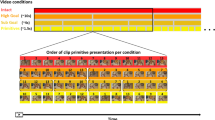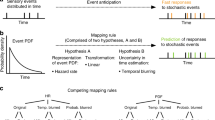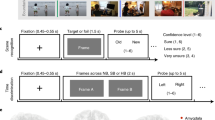Abstract
Temporal structure has a major role in human understanding of everyday events. Observers are able to segment ongoing activity into temporal parts and sub-parts that are reliable, meaningful and correlated with ecologically relevant features of the action. Here we present evidence that a network of brain regions is tuned to perceptually salient event boundaries, both during intentional event segmentation and during naive passive viewing of events. Activity within this network may provide a basis for parsing the temporally evolving environment into meaningful units.
This is a preview of subscription content, access via your institution
Access options
Subscribe to this journal
Receive 12 print issues and online access
$209.00 per year
only $17.42 per issue
Buy this article
- Purchase on Springer Link
- Instant access to full article PDF
Prices may be subject to local taxes which are calculated during checkout

Similar content being viewed by others
References
Wynn, K. Infants' individuation and enumeration of actions. Psychol. Sci. 7, 164–169 (1996).
Nelson, K. & Gruendel, J. in Event Knowledge: Structure and Function in Development (ed. Nelson, K.) 21–46 (Lawrence Erlbaum Associates, Hillsdale, New Jersey, 1986).
Zacks, J. M. & Tversky, B. Event structure in perception and conception. Psychol. Bull. 127, 3–21 (2001).
Newtson, D., Engquist, G. & Bois, J. The objective basis of behavior units. J. Pers. Soc. Psychol. 35, 847–862 (1977).
Newtson, D. & Engquist, G. The perceptual organization of ongoing behavior. J. Exp. Soc. Psychol. 12, 436–450 (1976).
Avrahami, J. & Kareev, Y. The emergence of events. Cognition 53, 239–261 (1994).
Zacks, J. M., Tversky, B. & Iyer, G. Perceiving, remembering, and communicating structure in events. J. Exp. Psychol. Gen. 130, 29–58 (2001).
Watson, J. D. et al. Area V5 of the human brain: evidence from a combined study using positron emission tomography and magnetic resonance imaging. Cereb. Cortex 3, 79–94 (1993).
Tootell, R. B. & Taylor, J. B. Anatomical evidence for MT and additional cortical visual areas in humans. Cereb. Cortex 5, 39–55 (1995).
Van Essen, D. C. & Drury, H. A. Structural and functional analyses of human cerebral cortex using a surface-based atlas. J. Neurosci. 17, 7079–7102 (1997).
Bonda, E., Petrides, M., Ostry, D. & Evans, A. Specific involvement of human parietal systems and the amygdala in the perception of biological motion. J. Neurosci. 16, 3737–3744 (1996).
Decety, J. & Grezes, J. Neural mechanisms subserving the perception of human actions. Trends Cogn. Sci. 3, 172–178 (1999).
Corbetta, M. et al. A common network of functional areas for attention and eye movements. Neuron 21, 761–773 (1998).
Corbetta, M. Frontoparietal cortical networks for directing attention and the eye to visual locations: identical, independent, or overlapping neural systems? Proc. Natl. Acad. Sci. USA 95, 831–838 (1998).
McDermott, K. B., Buckner, R. L., Petersen, S. E., Kelley, W. M. & Sanders, A. L. Set- and code-specific activation in frontal cortex: an fMRI study of encoding and retrieval of faces and words. J. Cogn. Neurosci. 11, 631–640 (1999).
Lumer, E. D., Friston, K. J. & Rees, G. Neural correlates of perceptual rivalry in the human brain. Science 280, 1930–1934 (1998).
Lumer, E. D. & Rees, G. Covariation of activity in visual and prefrontal cortex associated with subjective visual perception. Proc. Natl. Acad. Sci. USA 96, 1669–1673 (1999).
Tong, F., Nakayama, K., Vaughan, J. T. & Kanwisher, N. Binocular rivalry and visual awareness in human extrastriate cortex. Neuron 21, 753–759 (1998).
Dumoulin, S. O. et al. A new anatomical landmark for reliable identification of human area V5/MT: a quantitative analysis of sulcal patterning. Cereb. Cortex 10, 454–463 (2000).
Paus, T. Location and function of the human frontal eye-field: a selective review. Neuropsychologia 34, 475–483 (1996).
Grafman, J. Similarities and distinctions among current models of prefrontal cortical functions. Ann. NY Acad. Sci. 769, 337–368 (1995).
Talairach, J. & Tournoux, P. Co-planar Stereotaxic Atlas of the Human Brain (Thieme, Stuttgart, 1988).
Miezin, F. M., Maccotta, L., Ollinger, J. M., Petersen, S. E. & Buckner, R. L. Characterizing the hemodynamic response: effects of presentation rate, sampling procedure, and the possibility of ordering brain activity based on relative timing. Neuroimage 11, 735–759 (2000).
Friston, K. A., Holmes, A., Worsley, K. & Poline, J. Statistical parametric maps in functional imaging: a general linear approach. Hum. Brain Mapp. 2, 189–210 (1995).
Ollinger, J. M. & McAvoy, M. P. in Functional Mapping of the Human Brain (eds. Mesulam, M.-M. & Bandettini, P.) (Academic, San Antonio, Texas, 2000).
Van Essen, D. C., Drury, H. A., Joshi, S. & Miller, M. I. Functional and structural mapping of human cerebral cortex: solutions are in the surfaces. Proc. Natl. Acad. Sci. USA 95, 788–795 (1998).
Acknowledgements
This research was supported in part by grants from the Mallinckrodt Institute of Radiology and the McDonnell Center for Higher Brain Function. The authors thank E. Akbudak, T.E. Conturo and D.C. Van Essen for their assistance, and B. Tversky for her comments.
Author information
Authors and Affiliations
Rights and permissions
About this article
Cite this article
Zacks, J., Braver, T., Sheridan, M. et al. Human brain activity time-locked to perceptual event boundaries. Nat Neurosci 4, 651–655 (2001). https://doi.org/10.1038/88486
Received:
Accepted:
Issue Date:
DOI: https://doi.org/10.1038/88486
This article is cited by
-
Multi-view manifold learning of human brain-state trajectories
Nature Computational Science (2023)
-
Neurons detect cognitive boundaries to structure episodic memories in humans
Nature Neuroscience (2022)
-
Predicting memory from the network structure of naturalistic events
Nature Communications (2022)
-
The neural bases for timing of durations
Nature Reviews Neuroscience (2022)
-
Cortical thickness distinguishes between major depression and schizophrenia in adolescents
BMC Psychiatry (2021)




